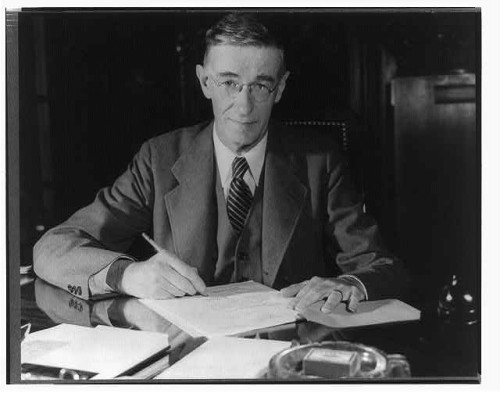Vannevar Bush
|
Vannevar Bush Vannevar Bush was never directly involved with the creation or development of the Internet. He died before the creation of the World Wide Web. Yet many consider Bush to be the Godfather of our wired age often making reference to his 1945 essay, "As We May Think." In his article, Bush described a theoretical machine he called a "memex," which was to enhance human memory by allowing the user to store and retrieve documents linked by associations. This associative linking was very similar to what is known today as hypertext. Indeed, Ted Nelson who later did pioneering work with hypertext credited Bush as his main influence (Zachary, 399). Others, such as J.C.R. Licklider and Douglas Engelbart have also paid homage to Bush. Vannevar Bush (March 11, 1890 – June 30, 1974) was an American engineer and science administrator known for his work on analog computing, his political role in the development of the atomic bomb, and the idea of the memex, which was seen decades later as a pioneering concept for the World Wide Web. A leading figure in the development of the military-industrial complex and the military funding of science in the United States, Bush was a prominent policymaker and public intellectual ("the patron saint of American science") during World War II and the ensuing Cold War, and was in effect the first presidential science advisor. Through his public career, Bush was a proponent of democratic technocracy and of the centrality of technological innovation and entrepreneurship for both economic and geopolitical security. His name is pronounced van-NEE-ver (with the same stresses as in "receiver") During World War I he worked with the National Research Council in developing improved techniques for detecting submarines. He joined the Department of Electrical Engineering at MIT in 1919, and was a professor there from 1923–32. In 1922, Bush and his college roommate, Laurence K. Marshall, set up the American Appliance Company to market a device called the S-tube. This was a gaseous rectifier invented by C. G. Smith that greatly improved the efficiency of radios. Bush made a lot of money from the venture. The company, renamed Raytheon, became an electronics giant and a defense contractor. Starting from 1927, Bush constructed a Differential Analyser, an analog computer that could solve differential equations with as many as 18 independent variables. An offshoot of the work at MIT was the birth of digital circuit design theory by one of Bush's graduate students, Claude Shannon. Historical Timeline for Vannevar Bush :
|
|










